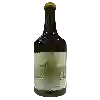
Caveau ChancenardVin Jaune Côtes du Jura
This wine generally goes well with poultry, mature and hard cheese or mushrooms.
Food and wine pairings with Vin Jaune Côtes du Jura
Pairings that work perfectly with Vin Jaune Côtes du Jura
Original food and wine pairings with Vin Jaune Côtes du Jura
The Vin Jaune Côtes du Jura of Caveau Chancenard matches generally quite well with dishes of spicy food, mature and hard cheese or poultry such as recipes of makrouna salsa (tunisian pastry), tomato, ham, cheese and mushroom pie or chicken chawarma.
Details and technical informations about Caveau Chancenard's Vin Jaune Côtes du Jura.
Discover the grape variety: Marsanne
Marsanne is a white grape variety that originated in Montélimar in the Drôme, several centuries ago. Marsanne is also found in Cassis, Savoie, Languedoc-Roussillon and Saint-Péray in the Ardèche, where it produces remarkable sparkling wines. The warm, sunny climate of the Rhone Valley, Languedoc-Roussillon and Provence, as well as the dry, stony soil, are ideal conditions for its development. Its bunches are quite large and provide small, juicy berries that are sensitive to grey rot and strong winds. These two grape varieties complement each other perfectly: together they give light wines with little acidity, aromas of yellow fruit, white fruit and flowers with notes of honey and liquorice. This is for example what the appellations Saint-Péray, Hermitage, Crozes-Hermitage, Saint-Joseph, Côtes-du-Vallée du Rhône, Corbières, or Cassis express... which represent about 700 hectares.
Last vintages of this wine
The best vintages of Vin Jaune Côtes du Jura from Caveau Chancenard are 0
Informations about the Caveau Chancenard
The Caveau Chancenard is one of of the world's greatest estates. It offers 17 wines for sale in the of Côtes du Jura to come and discover on site or to buy online.
The wine region of Côtes du Jura
Côtes du Jura is a regional appellation in the Jura wine region of eastern France. Introduced in 1937, it is arguably the largest appellation in the region in terms of geographical extent. In terms of quantity, it is the second largest after Arbois">Arbois. While the vast majority of Jura wines are produced in the Northern half of the region between Etoile and Arbois, the Côtes du Jura catchment area extends some distance to the South.
The wine region of Jura
The Jura is a small wine region in eastern France that is responsible for some very special and traditional wine styles. It is close to the Swiss Jura, but quite distinct from it. Wedged between Burgundy to the west and Switzerland to the east, the region is characterized by a landscape of Wooded hills and the winding topography of the Jura Mountains. The Jura vineyards cover just over 1,850 hectares, forming a narrow strip of land almost 80 km Long from North to South.
The word of the wine: Oxidative (breeding)
A method of ageing which aims to give the wine certain aromas of evolution (dried fruit, bitter orange, coffee, rancio, etc.) by exposing it to the air; it is then matured either in barrels, demi-muids or unoaked casks, sometimes stored in the open air, or in barrels exposed to the sun and to temperature variations. This type of maturation characterizes certain natural sweet wines, ports and other liqueur wines.














